The Acer Nitro 5 Gaming Laptop Review: Absolutely AMD - Ryzen Plus Polaris
by Brett Howse on February 15, 2019 8:30 AM ESTDisplay Analysis
Acer’s Nitro 5 offers a 1920x1080 15.6-inch display which is an IPS panel, which is great to see. Even though this is a value offering, it would have been disappointing to see a TN display, so well done Acer. That is about where the good qualities of this display end, unfortunately.
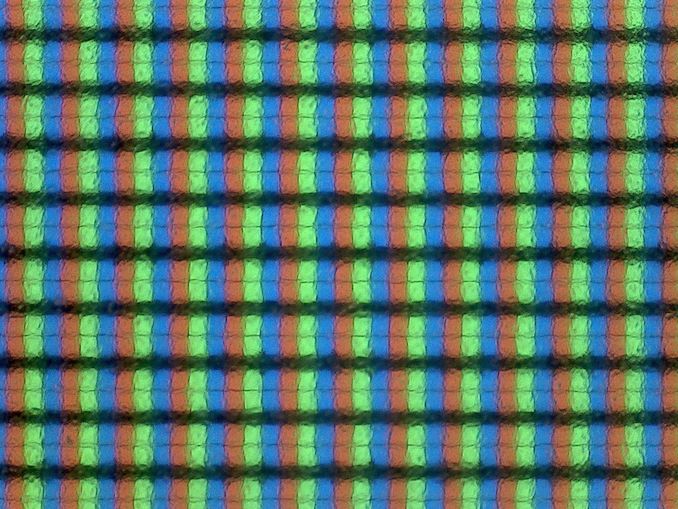 Acer Nitro 5 Subpixels with Anti-Glare coating
Acer Nitro 5 Subpixels with Anti-Glare coating
At 15.6-inches in size, the 1920x1080 resolution does allow you to run 100% scaling without the elements getting too small. That’s a benefit for sure, since you won’t get the artifacts that can still existing when using scaling in Windows 10. There’s been a lot of improvements to the OS to correct this, but not all applications have taken the time to ever deal with it. Luckily that won’t be a concern at 100%.
To test the display we use SpectraCal’s CalMAN suite with a custom workflow. Brightness and contrast readings are taken with the X-Rite i1Display Pro colorimeter, and color readings are taken with the X-Rite i1Pro2 spectrophotometer.
Brightness and Contrast
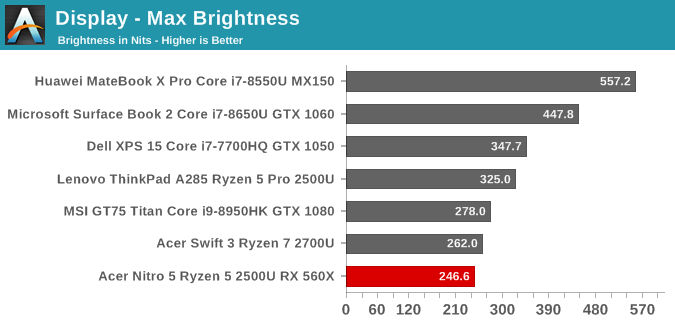
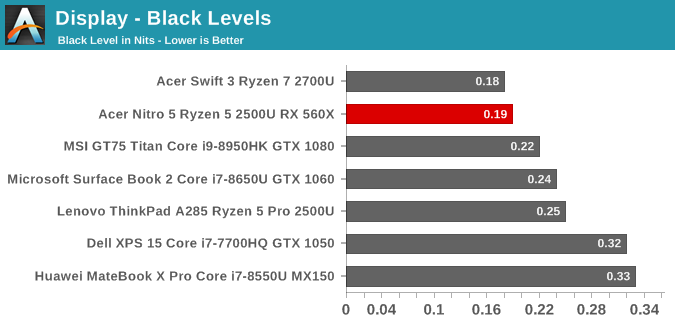
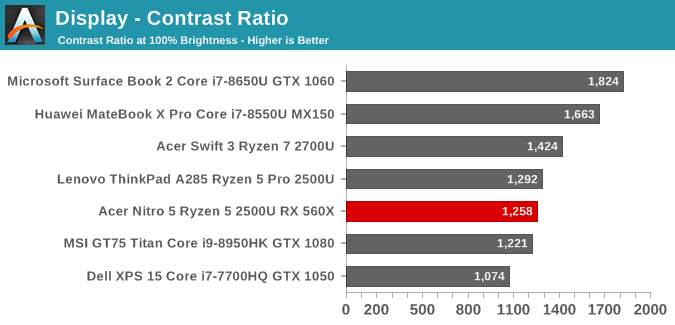
The panel on the Nitro 5 doesn’t get particularly bright, topping out at just 246 nits. It also doesn’t get particularly dark either, with a minimum brightness of 16 nits. But both values are likely fine for use indoors on a desk. The black levels are quite good though, leading to a solid contrast ratio of 1258:1 at maximum brightness.
Grayscale
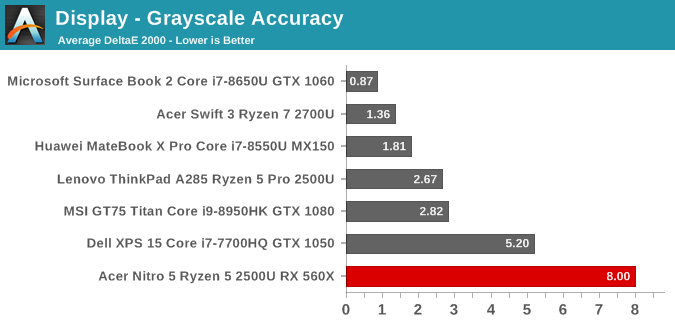
Here is where things start to get unravelled for the Nitro 5. The grayscale accuracy is terrible, thanks to the green part of the backlight being far too bright at almost any point in the range. The gamma curve is also well off the 2.2 value expected, falling increasingly under that point starting at around 35% brightness. This means there will be less of a dynamic range between highs and lows as you go towards greater brightness levels.
Gamut
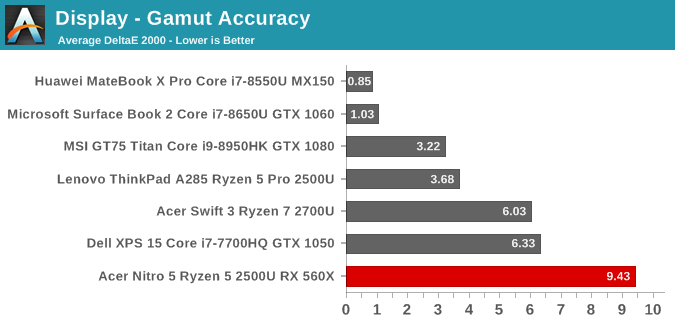
Here we can start to see the problems inherent in this display. The greens are the only colors even close to hitting the sRGB gamut, with red well under and blue doing its best impression of Hawaii. The graph ranges had to be adjusted just to see on the chart how far blue is off the mark, and at almost a dE2000 of 25, it is very, very far from where it should be.
Saturation
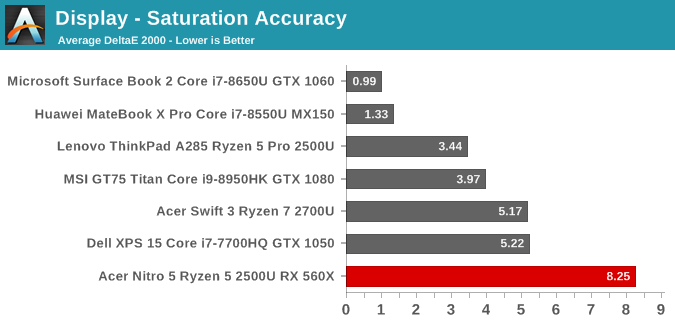
Gamut is the primary and secondary colors at 100% brightness, whereas with the saturation sweep we test with 4-bit steps from 0% to 100%. It’s amazing just how far off the blue levels are, and coupled with the less than amazing reds, the magenta values are also dramatically impacted.
Gretag Macbeth
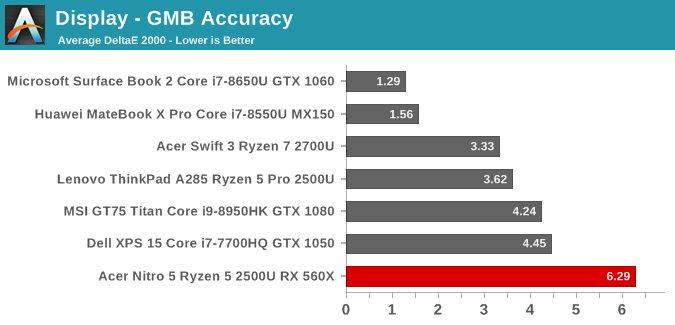
This graph also needed to have almost all of the charts adjusted to show just how far off the mark the colors are on this display. Considering the less than amazing primary colors, it’s no shock that every single color is pretty much terrible.
Colorchecker
This image shows the intended color on the bottom, and the achieved color on the top, so it gives a nice representation of the previous tests. The whites are very green, and the colors are mostly terrible.
Display Conclusion
This display is possibly the least accurate IPS panel we have ever tested. The uncalibrated panel is coupled with a backlight that can’t even come close to covering the entire sRGB spectrum. The Acer Nitro 5 is an entry-level device, and the display is one of the ways they made it to their target price.















90 Comments
View All Comments
Oxford Guy - Saturday, February 16, 2019 - link
Unfortunately, it looks like the ColorMunki's price has gone way up and its software may not be reliable with Windows 10.GreenReaper - Monday, February 18, 2019 - link
It'll probably go on sale at some point and you can buy it then. I never even installed the software, just DisplayCal.Brett Howse - Saturday, February 16, 2019 - link
You can't calibrate when the backlight won't do sRGB. There's no way to get more blue out of the light than is available. All calibration would do is lead to some pretty extensive crushing.Oxford Guy - Sunday, February 17, 2019 - link
I read too quickly and thought you meant the panel had excessive coverage in the blue range. I see that it's the opposite. Usually with cheap laptop screens a very low contrast ratio accompanies strong sRGB undercoverage. A ratio of over 1000 is surprising for a screen with such poor gamut.Some undercoverage of sRGB can still really benefit from calibration, as seen here in the greens:
http://www.tftcentral.co.uk/reviews/viewsonic_vx24...
http://www.tftcentral.co.uk/reviews/asus_ms246h.ht...
http://www.tftcentral.co.uk/reviews/benq_ew2420.ht...
However, if it is severe as this laptop's is, then it's probably not worth the trouble.
GreenReaper - Monday, February 18, 2019 - link
Our eye responds more to green light, so I guess it's one way to easily boost perceived brightness and hence contrast ratios (as long as there isn't too much leakage as well).Calibration makes the crappy TN screen on my Lenovo X120e look a heck of a lot better, even if it's obviously not as good as my other displays - reasonably consistency within its coverage area is key.
Arbie - Friday, February 15, 2019 - link
Saying that one thing is "100% faster" than another means it is twice as fast. You do this repeatedly, where what you meant is "100% as fast". The two are wildly different.Brett Howse - Friday, February 15, 2019 - link
Appreciate the feedback and updating the wording.LMonty - Saturday, February 16, 2019 - link
I'm glad Brett is confident enough to appreciate valid corrections. :) Many tech writers ignore comments like this or even deny them.Brett Howse - Saturday, February 16, 2019 - link
I wrote one thing while meaning another - I always appreciate constructive feedback!nathanddrews - Friday, February 15, 2019 - link
At first glance - looks like decent budget gaming option. Looking closer:1. WTF is up with single-channel AMD notebooks? It literally HALVES APU performance in some games and significantly nerfs most other CPU operations. If you still have access to this laptop, please consider tossing in another stick of RAM.
2. That IPS display *shudder*. At what point does it even matter if it's going to be of such low quality? Also, why not FreeSync?
3. What's up with the 1060 and 1050 on the gaming charts dramatically switching positions? Are there some throttling issues at play?